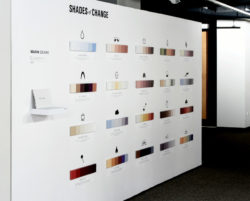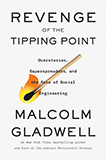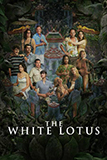…or so I think.
I had written before that I have a gift of seeing color. I always saw colors others couldn’t…but I just brushed it off as one of those weird, quirky things about me.
Now I’ve discovered that there may be a scientific explanation: I may be a tetrachromat. A what-a-mat? A genetic mutation that allows some women (sorry guys, girls only) to see 100 million colors as opposed to the normal 1 million.
Here is the full article from Pittsburgh Post-Gazette:
Some women may see 100 million colors, thanks to their genes
Wednesday, September 13, 2006
By Mark Roth, Pittsburgh Post-Gazette
Susan Hogan can’t be sure, but it wouldn’t surprise her if she turned out to be a tetrachromat.
A tetrachromat is a woman who can see four distinct ranges of color, instead of the three that most of us live with.
A genetic test would be needed to verify whether Mrs. Hogan truly fits that description, but it could help explain why the interior decorator can hold up three samples of beige wall paint, “and I can see gold in one and gray in another and green in another, but my clients can’t tell the difference.”
It may be impossible for us trichromats to imagine what a four-color world would look like. But mathematics alone suggests the difference would be astounding, said Jay Neitz, a renowned color vision researcher at the Medical College of Wisconsin.
Each of the three standard color-detecting cones in the retina — blue, green and red — can pick up about 100 different gradations of color, Dr. Neitz estimated. But the brain can combine those variations exponentially, he said, so that the average person can distinguish about 1 million different hues.
A true tetrachromat has another type of cone in between the red and green — somewhere in the orange range — and its 100 shades theoretically would allow her to see 100 million different colors.
That may be why Mrs. Hogan can look out the windows of her Mount Washington home and tell the relative depths and silting of the three rivers at the Point by discerning the subtle differences in their shades.
“I have a very hard time even giving names to colors because I see so many other colors inside them,” she said.
Dr. Neitz, who conducts his research with his wife Maureen, said only women have the potential for super color vision.
That’s because the genes for the pigments in green and red cones lie on the X chromosome, and only women have two X chromosomes, creating the opportunity for one type of red cone to be activated on one X chromosome and the other type of red cone on the other one. In a few cases, women may have two distinct green cones on either X chromosome.
But it’s unlikely, Dr. Neitz said, that all of the women with four types of color cones will have the potential for superior color vision, because for many, their two red cones will be so close to each other in the wavelengths they detect that they won’t see things much differently than a three-color person does.
He estimated that 2 percent to 3 percent of the world’s women may have the kind of fourth cone that lies smack between the standard red and green cones, which could give them a colossal range.
Finding tetrachromats through genetic screening is one thing. Proving they can see tens of millions of additional colors is another.
One research group that believes it has identified a true tetrachromat is headed by Gabriele Jordan of Newcastle University in Great Britain.
Dr. Jordan started by working backward from certain “color blind” boys to their mothers.
About 8 percent of the world’s men have color deficiency, which is the term vision researchers prefer to color blindness.
Most of them inherit two red or two green cones along with the standard blue cone, making it impossible for them to distinguish between red and green peppers, or tell how well-done a steak is, or pick out matching clothes.
Dr. Jordan’s team used vision tests to identify more than a hundred schoolboys in the Newcastle area with that kind of color deficiency.
She knew that the mothers of those boys would have either two red or two green cones, and she is now in the process of testing those women to see which of them might be “strong tetrachromats,” as she put it.
To single out such women, she came up with a clever test. Each woman looks into an optical device that shows her three tiny discs in rapid succession. Two of the discs are a pure orange wavelength and the third is a nearly identical mixture of red and green. The women aren’t told which is which.
Dr. Jordan reasoned that women with two distinct red cones would see the red-green disc differently than the orange discs.
Of the 20 women she has tested so far, only one was able to instantly and accurately identify the red-green disc each time. She is now conducting genetic tests on the woman’s saliva to verify whether she has the genes for distinct red cones.
Dr. Jordan said that the woman, who has not yet been identified, is a physician near Newcastle.
For a doctor, she speculated, super color vision might give her the ability to tell whether a patient is ill just by noticing subtle changes in skin tone that a normal doctor wouldn’t see.
Based on Dr. Neitz’s estimates, there could be 99 million women in the world with true four-color vision.
But before they pat themselves on the back for their superior evolution, he said, it’s important to note that humans are just getting back to where birds, amphibians and reptiles have been for eons.
Those creatures have long had four-color vision, but a key difference is that their fourth type of color detector is in the high-frequency ultraviolet range, beyond where humans can see.
In fact, that finding allowed scientists to figure out recently why the males of some species of birds did not appear to have brighter plumage than the females, Dr. Neitz said.
The problem was in the observers, not the birds, he said. When those species were viewed through ultraviolet detectors, the males had markedly different feathers than the females.
In a similar way, he said, our eyes aren’t capable of seeing the world the way a true four-color viewer perceives it, and so we have no way of knowing how many advantages that might give to the tetrachromats.
“There are many things in the world that are physically different from one another that you can’t tell apart now” with three-color vision, he said, but a four-color woman presumably would see the distinctions.
And sometimes the edge may just be aesthetic.
Which could be why, when Susan Hogan’s husband puts a new piece of fruit in their fruit bowl, “I have to rearrange it so the colors go together right,” she said with a laugh.
First published on September 13, 2006 at 12:00 am
Mark Roth can be reached at mroth@post-gazette.com or at 412-263-1130.
Although this is pretty cool, I don’t think I’ll get my DNA tested. Who knows what other weird things they’ll find out about me?






 I like books, gadgets, spicy food, and art. I dislike shopping, hot weather, and the laws of entropy. Although I am a self-proclaimed computer nerd, I still have a love for handbags and makeup... and I am always teetering on high heels. To learn more about me, visit the
I like books, gadgets, spicy food, and art. I dislike shopping, hot weather, and the laws of entropy. Although I am a self-proclaimed computer nerd, I still have a love for handbags and makeup... and I am always teetering on high heels. To learn more about me, visit the 


Hi, I too feel i have an acute awareness of colour and feel i could be a tetrachromat. I used to work my powers behind the cosmetic sales counter. I had one return from a customer (of foundation) in seven years. Not bad!
Just to make one contemplation right.
You bi.ch I’m not colorblind I just do NOT have the need give the weird names to the colour that no one can match to give you what colour you want because only you know what colour exactly, I mean EXACTLY.
Salmon colour can be diferent from wild and breeding ones.
At least I know why you have to sit with your friends chating 3 hours straight because get the other girl to understad EXACTLY the colour you mean takes 179min.